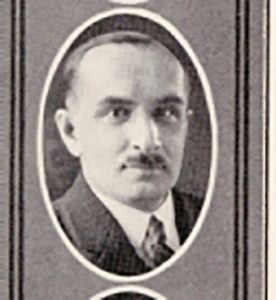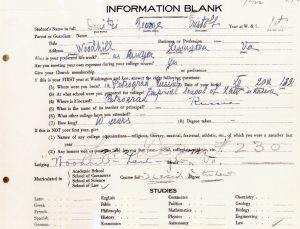

Above, Prince Dimitri George Sidamon-Eristoff as a second year law student at Washington and Lee University in 1924. On the right is the registration information from Sidamon-Eristoff’s first year of law school.
The year 1922 brought royalty to the Washington and Lee University School of Law student body in the person of Georgian Prince Dimitri Sidamon-Eristoff. Charles Moser, who was United States Consul to several countries, including Georgia, and who had “special detail” at Constantinople, arranged for visas for 3 Georgian princes (Simon, Dimitri, and Pierre) to travel to the US in 1921. Moser would also provide passage for Dimitri’s sister Xenia and her mother to come the US. Moser married Xenia in 1923. Moser already owned a house in Lexington, and they lived there. He suggested to Dimitri that he study law at W&L. Dimitri had extensive law training in St. Petersburg and spoke English well.
A “Russian Student Fund” (RSF) was set up by several wealthy Americans and the Russian Provisional Government’s Ambassador to the US, Bakhmeteff, to help White Russian emigres get a quality education with an eye toward creating better US-Russian relations if the Bolsheviks regime would collapse. The RSF encouraged a number of United States universities and colleges to offer scholarships to the most promising emigres, supplemented by funds from the RSF. Dimitri and Simon, (and perhaps Pierre as well) were among the first recipients of those scholarships.
Sidamon-Eristoff was a member of Phi Beta Kappa when he graduated with a Bachelor of Law degree in 1925. On February 20, 1926, he delivered an address in New York City to the American Foreign Law Association on the workings of Soviet law. It was published as Principles of Russian Soviet Law.
He practiced law for many years in Brooklyn, NY. On his death, his son George (B.A. Washington and Lee 1953) wrote, ‘I regret to inform you that “The Prince,” known as “The Iron Man” to some, passed away Oct. 22nd, 1969. He had a long and good life. And while every man has his regrets, he, perhaps, had fewer than most.’
For details of the remarkable story of Eristoff’s life before he came to the United States, see Doug Harwood’s story on page 50 of the April 2019 edition of his monthly newspaper, The Rockbridge Advocate.
Thanks to Richard Bidlack, Martin and Brooke Stein Professor of History at W&L, for bringing Sidamon-Eristoff to my attention and providing biographical information. Special thanks to Jane Smith of University Development and Lisa McCown of Leyburn Library Special Collections.
 If you weren’t able to make it to the event on 3/16 (the best attended ever!), or if you were there but want a refresher, you can review materials from the program online at https://libguides.wlu.edu/summersuccess2019.
If you weren’t able to make it to the event on 3/16 (the best attended ever!), or if you were there but want a refresher, you can review materials from the program online at https://libguides.wlu.edu/summersuccess2019.

 Join members of the W&L Law faculty to discuss Just Mercy, the bestselling true story of a lawyer exonerating the wrongly convicted and representing society’s most vulnerable through the perils of our justice system. From 5:00pm to 6:30pm in Law Classroom A on Wednesday, March 27. An informal reception with light hors d’oeuvres will follow in the Moot Court Lobby. Hosted by the W&L Law Library and open to all members of the W&L community and public. Featuring perspectives from W&L Law professors:
Join members of the W&L Law faculty to discuss Just Mercy, the bestselling true story of a lawyer exonerating the wrongly convicted and representing society’s most vulnerable through the perils of our justice system. From 5:00pm to 6:30pm in Law Classroom A on Wednesday, March 27. An informal reception with light hors d’oeuvres will follow in the Moot Court Lobby. Hosted by the W&L Law Library and open to all members of the W&L community and public. Featuring perspectives from W&L Law professors: